1: Camassia leichtlinii alba. We’ve tried other Camassias in the garden over the last 3 years, and been delighted by how they add height and colour amongst early flowering perennials in May, and tend to mask dying foliage from earlier spring bulbs. Many are natives of North American meadows and seem to like our fairly wet heavy soil, coping with full sun or part shade. Last year we planted a couple of hundred of this white form, hoping to lighten a few areas amongst predominantly spring green foliage.
Many are natives of North American meadows and seem to like our fairly wet heavy soil, coping with full sun or part shade. Last year we planted a couple of hundred of this white form, hoping to lighten a few areas amongst predominantly spring green foliage. Apart from being favoured bee flowers, for bumbles and honey bees, the white form is a bit taller and seems to flower a fortnight or so later than the blue C. l. caerulea. It also looks brilliant with the reliable and long mauve flowering Polemonium “Lambrook Mauve”, which narrowly missed this selection.
Apart from being favoured bee flowers, for bumbles and honey bees, the white form is a bit taller and seems to flower a fortnight or so later than the blue C. l. caerulea. It also looks brilliant with the reliable and long mauve flowering Polemonium “Lambrook Mauve”, which narrowly missed this selection.
2: “The Lakeland Rose”. A recently bred climbing rose, which is meant to reach 6 to 7 feet. We’ve had one for 3 years now, planted at the base of one of my chainsawed mushrooms.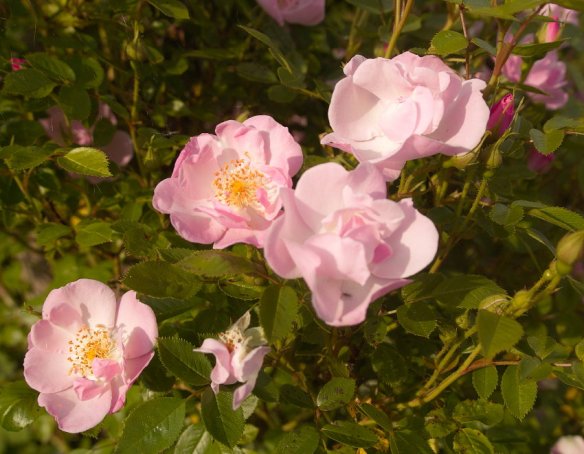 So thriving in spite of a pretty impoverished site, given the mushroom was hewn from a mature, felled Norway Spruce. Having now settled in, this year it has been a delight with fairly disease resistant foliage (we never spray our roses, so they have to be toughies), and one of the earliest roses into flower. The smallish single delicate pink flowers have a fabulous subtle scent, and seem to be produced in very large numbers. It’s easy to train round this awkward shape, and we’ve got a Clematis texensis “Etoile rose”, twining through it.
So thriving in spite of a pretty impoverished site, given the mushroom was hewn from a mature, felled Norway Spruce. Having now settled in, this year it has been a delight with fairly disease resistant foliage (we never spray our roses, so they have to be toughies), and one of the earliest roses into flower. The smallish single delicate pink flowers have a fabulous subtle scent, and seem to be produced in very large numbers. It’s easy to train round this awkward shape, and we’ve got a Clematis texensis “Etoile rose”, twining through it.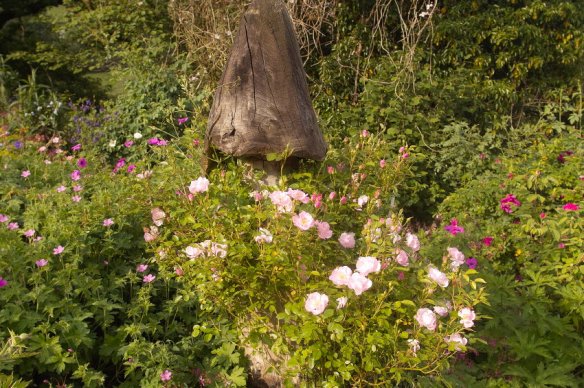 I like the effect so much, I’m tempted to repeat it up some of the other mushrooms. Bees love the flowers too, and it does produce tiny orange hips if not deadheaded – but it’s one of those few plants I love so much, I occasionally nip off the short lived flowers when I can remember, to try to keep it flowering for longer.
I like the effect so much, I’m tempted to repeat it up some of the other mushrooms. Bees love the flowers too, and it does produce tiny orange hips if not deadheaded – but it’s one of those few plants I love so much, I occasionally nip off the short lived flowers when I can remember, to try to keep it flowering for longer.
3: Honeysuckle. Lonicera periclymenum (?) We planted a couple of honeysuckle to grow over the slate topped wall outside the front of the cottage very early on, and I have no idea what form they are. But in early June, they flood the air outside the front door with that sublime mid summer perfume. This year they are flowering better than ever. Is this a result of severe cutting back last year? Or because of seasonal variations?
But in early June, they flood the air outside the front door with that sublime mid summer perfume. This year they are flowering better than ever. Is this a result of severe cutting back last year? Or because of seasonal variations?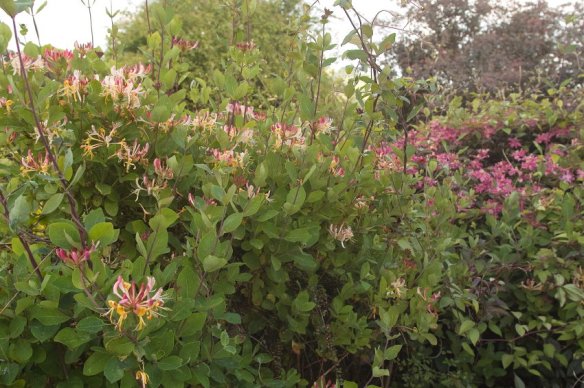 Or even because of my use of dried seaweed for the last 2 years, and hence some trace mineral supplementation? Who knows, but yet another flower appreciated by many of our garden insects – bumble bees, flies, moths.
Or even because of my use of dried seaweed for the last 2 years, and hence some trace mineral supplementation? Who knows, but yet another flower appreciated by many of our garden insects – bumble bees, flies, moths.
4: Geranium sanguineum var. striatum. A variation of the native bloody cranesbill. This is one of our very favourite perennial Geraniums. Forming a low growing mat of small, prettily cut leaves, it begins to produce its attractive pale pink flowers with deeper red veining at the end of May and continues for many weeks.
Forming a low growing mat of small, prettily cut leaves, it begins to produce its attractive pale pink flowers with deeper red veining at the end of May and continues for many weeks. It associates with many of our other native cliff top flowers, growing amongst cobbles, or the gravel of the yard, so survives very well in poor soil and sunny, drier locations, and even in our very dry chimney pots (see combination with Erodium below)…
It associates with many of our other native cliff top flowers, growing amongst cobbles, or the gravel of the yard, so survives very well in poor soil and sunny, drier locations, and even in our very dry chimney pots (see combination with Erodium below)… It seeds around gently, but never becomes a thug unlike several of its more vigorous cousins.
It seeds around gently, but never becomes a thug unlike several of its more vigorous cousins.
5: Sambucus nigra ‘Black Lace’ . A finely cut variant of the common elder, the distinctive black leaves look lovely throughout the year, whatever the weather, with typical dark berries forming in the autumn. But right now, when the pink tinged flowers appear setting off this very dark foliage, the effect is stunning. This year I’ve seen it paired with a white Paeony and pale lilac perennial honesty flowers in Shelly Pike’s Talley Bryn Heulog garden to great effect…
But right now, when the pink tinged flowers appear setting off this very dark foliage, the effect is stunning. This year I’ve seen it paired with a white Paeony and pale lilac perennial honesty flowers in Shelly Pike’s Talley Bryn Heulog garden to great effect…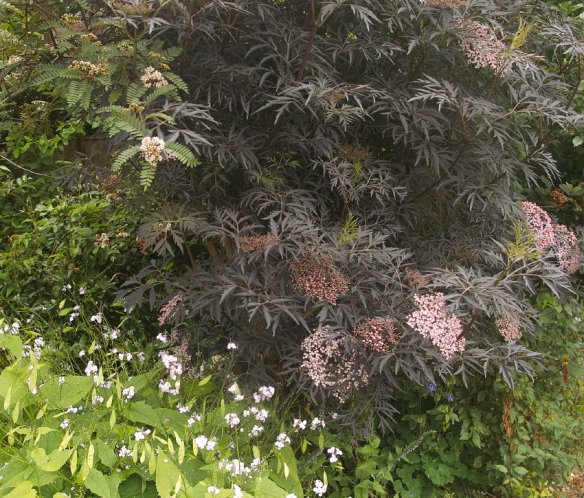 We prune ours back each year to regenerate it, and to try to keep it a more manageable smaller shrub size.
We prune ours back each year to regenerate it, and to try to keep it a more manageable smaller shrub size.
6: Erodium manescavii. A storksbill originating from the Pyrenees, I’m surprised that this grows so well with us, but in full sun and in our relatively free draining stony terrace garden, it thrives and seeds around gently. It’s deep pink flowers attract flies and bumblebees. It also copes with the very free draining position at the top of our 3 flower filled chimney pots. These pots, surrounded by Bowle’s Golden Sedge, are meant to hint at the unseen furnace of activity below ground with root and fungal interactions fuelling the visual floral display above ground, which all gardeners are focused on. We’ve had 3 or 4 variations on plants to use in these pots. This combination seems very reliable in this role, with the aforementioned G. sanguineum striatum.
It also copes with the very free draining position at the top of our 3 flower filled chimney pots. These pots, surrounded by Bowle’s Golden Sedge, are meant to hint at the unseen furnace of activity below ground with root and fungal interactions fuelling the visual floral display above ground, which all gardeners are focused on. We’ve had 3 or 4 variations on plants to use in these pots. This combination seems very reliable in this role, with the aforementioned G. sanguineum striatum.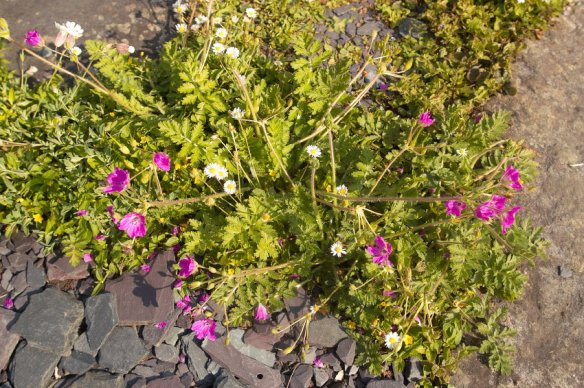 Unlike many Geraniums, this Erodium coexists well with other low growing, spreading plants, never dominating the scene, and if deadheaded occasionally, it will flower continuously for months until the first frosts. Probably because the foliage is more open, and low growing, forming a sort of central rosette of leaves. Its’ seeds also have the most fascinating morphology, with a corkscrew awn designed to drill the seed down into tiny cracks to aid germination.
Unlike many Geraniums, this Erodium coexists well with other low growing, spreading plants, never dominating the scene, and if deadheaded occasionally, it will flower continuously for months until the first frosts. Probably because the foliage is more open, and low growing, forming a sort of central rosette of leaves. Its’ seeds also have the most fascinating morphology, with a corkscrew awn designed to drill the seed down into tiny cracks to aid germination.
7: Nectaroscordum siculum ssp. bulgaricum. An Allium type flower. We’ve experimented with Alliums in our garden, and generally they don’t perform that reliably, probably because of the wet conditions, as well as slug damage. However this is reliable with us in full sun, or part shade, returning for many years. It adds height interest to the garden, without affecting the lower growing groundcover. Here the flower buds stand well above earlier flowering Aquilegia vulgaris, and whether sunny or drizzly, the opened flowers are fantastic nectar magnets for several bumblebees and wasps.
However this is reliable with us in full sun, or part shade, returning for many years. It adds height interest to the garden, without affecting the lower growing groundcover. Here the flower buds stand well above earlier flowering Aquilegia vulgaris, and whether sunny or drizzly, the opened flowers are fantastic nectar magnets for several bumblebees and wasps. But don’t try the nectar yourself unless you’re a big garlic fan, since the taste lingers for ages. 2016 saw the often dominant wasps arriving late on the scene. By then many of the individual flowers which become drooping and pendulous after emerging from the upward pointing sheath had already been fertilised by the bumblebees…
But don’t try the nectar yourself unless you’re a big garlic fan, since the taste lingers for ages. 2016 saw the often dominant wasps arriving late on the scene. By then many of the individual flowers which become drooping and pendulous after emerging from the upward pointing sheath had already been fertilised by the bumblebees… The bonus feature of this plant now becomes apparent – the flowers swiftly grow back upwards to create clusters of fairy castle turrets, (appropriate for our magic terrace garden), which last for a few months. In spite of their long flower stems, they’re very wind resistant, and rarely blow over.
The bonus feature of this plant now becomes apparent – the flowers swiftly grow back upwards to create clusters of fairy castle turrets, (appropriate for our magic terrace garden), which last for a few months. In spite of their long flower stems, they’re very wind resistant, and rarely blow over.
8: Viola cornuta ‘Alba’. A vigorous low growing form of the horned Viola, which is very easy to propagate from self rooted layers, as well as seed. So it’s easy to dot it around all over the garden. In sun or shade, or even in pots, its’ small bright white flowers contrasting with the lovely deep green leaves combine well with so many plants, and under grey skies often lift the scene throughout the garden.
So it’s easy to dot it around all over the garden. In sun or shade, or even in pots, its’ small bright white flowers contrasting with the lovely deep green leaves combine well with so many plants, and under grey skies often lift the scene throughout the garden. I rarely seen insects visiting the flowers, but somehow they get pollinated, and like the Nectaroscordum, the developing seed capsules then flip through 180 degrees, before eventually splitting and flinging the seeds around.
I rarely seen insects visiting the flowers, but somehow they get pollinated, and like the Nectaroscordum, the developing seed capsules then flip through 180 degrees, before eventually splitting and flinging the seeds around. But never a thug, and always enjoyed wherever it pops up.
But never a thug, and always enjoyed wherever it pops up.
9: Geranium macrorrhizum. One of those invaluable ground cover plants for awkward dry shaded places, beneath trees and shrubs, even right up to trunk bases. That’s a mature Larch trunk base at the top right corner of the picture below … In 2016 it was a little late into flower, often emerging in mid May. In shades of whites and pinks, it is reliably floriferous and perennial, but being of fairly low height, doesn’t create issues for taller early spring bulbs growing from beneath it. When in flower it is one of the most favoured bumblebee and honeybee flower in our garden – even when growing in deep shade, so is a very valuable nectar source, whatever the weather. Carpeting the ground beneath Amelanchiers, below…
In 2016 it was a little late into flower, often emerging in mid May. In shades of whites and pinks, it is reliably floriferous and perennial, but being of fairly low height, doesn’t create issues for taller early spring bulbs growing from beneath it. When in flower it is one of the most favoured bumblebee and honeybee flower in our garden – even when growing in deep shade, so is a very valuable nectar source, whatever the weather. Carpeting the ground beneath Amelanchiers, below… It’s also quite easy to pull up, since the spreading stems are very shallowly rooted – unlike many other thug like perennial Geraniums. In our wet conditions, such stems will survive and eventually eradicate couch grass if just thrown onto the ground – providing there is sufficient shade.
It’s also quite easy to pull up, since the spreading stems are very shallowly rooted – unlike many other thug like perennial Geraniums. In our wet conditions, such stems will survive and eventually eradicate couch grass if just thrown onto the ground – providing there is sufficient shade. It will also seed around, but a very useful benign thug in the right place.
It will also seed around, but a very useful benign thug in the right place.
10. Candelabra Primula. Like P. japonica last month, I’m not entirely sure of the species name for these promiscuous Primulas which we’ve grown from collected seed… Possibly P. bulleyana? A range of orange, red, pink or yellow flowers, many on farina dusted stems, usually arranged in 5 tiers, which open sequentially to give weeks of colour…
Possibly P. bulleyana? A range of orange, red, pink or yellow flowers, many on farina dusted stems, usually arranged in 5 tiers, which open sequentially to give weeks of colour…
 They add splashes of colour in part shade or sun, wherever they decide to germinate, and unlike the earlier magenta ones described last time, seem to build up a base with several rosettes of leaves, and therefore multiple flower stems…
They add splashes of colour in part shade or sun, wherever they decide to germinate, and unlike the earlier magenta ones described last time, seem to build up a base with several rosettes of leaves, and therefore multiple flower stems…
 I very occasionally see a bumblebee visiting the flowers, whizzing round a flower whorl like the speeded up hands on a clock, but given the numbers of these flowers we have in the garden, they don’t seem to be real favourites with our insect fauna.
I very occasionally see a bumblebee visiting the flowers, whizzing round a flower whorl like the speeded up hands on a clock, but given the numbers of these flowers we have in the garden, they don’t seem to be real favourites with our insect fauna.
11. Rosa moyesii. An unusual rose, with its’ distinctive clear red flower colour, and simple single flower form. An unscented flower, but the medium sized shrub which survives in very impoverished shale where it is growing, flowers reliably over a short period, with the flowers offset by the small, matt green leaves. It is unusual in being hexaploid – having extra sets of chromosomes, and whether for this reason or not, insects of many types love the flowers as a pollen source. Bumblebees appear to buzz pollinate the flowers in an effort to shake off pollen.
An unscented flower, but the medium sized shrub which survives in very impoverished shale where it is growing, flowers reliably over a short period, with the flowers offset by the small, matt green leaves. It is unusual in being hexaploid – having extra sets of chromosomes, and whether for this reason or not, insects of many types love the flowers as a pollen source. Bumblebees appear to buzz pollinate the flowers in an effort to shake off pollen. The result of all this insect interest is that the flowers are short lived, but then go on to produce wonderful orange flagon shaped hips.
The result of all this insect interest is that the flowers are short lived, but then go on to produce wonderful orange flagon shaped hips. The 3 roses growing here in a clump to the left, were all grown from seeds extracted from hips collected from a mother plant elsewhere in the garden.
The 3 roses growing here in a clump to the left, were all grown from seeds extracted from hips collected from a mother plant elsewhere in the garden.
12. Geranium phaeum. A mid height Geranium valuable for its small, usually dark purple, flowers, and leaves with darker blotch markings.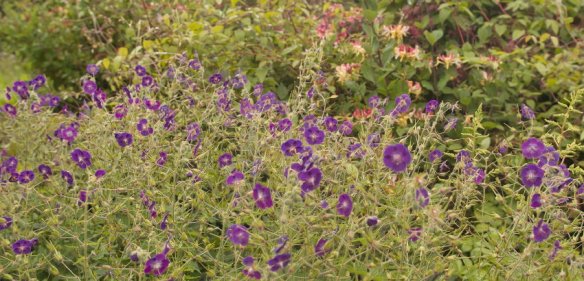 Along with G. macrorrhizum, it’s one of the most favoured Geranium flowers for small bumblebee species, and occasionally honeybees.
Along with G. macrorrhizum, it’s one of the most favoured Geranium flowers for small bumblebee species, and occasionally honeybees. Nearly all the plants in the garden are self seeders, but it’s not as thuggish a species as some others – we nearly always allow plants to stay where they pop up, since late May/ early June flowers are handy for us taking over from the many late daffodils, which brighten these spaces earlier in the year..
Nearly all the plants in the garden are self seeders, but it’s not as thuggish a species as some others – we nearly always allow plants to stay where they pop up, since late May/ early June flowers are handy for us taking over from the many late daffodils, which brighten these spaces earlier in the year.. Occasionally a nearly black form appears which are especially attractive, if partnered with a white or cream flower, as above.
Occasionally a nearly black form appears which are especially attractive, if partnered with a white or cream flower, as above.
___________________________________
